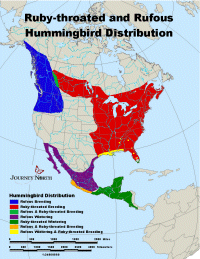Hummingbird
Migration Update: February
12, 2004
Today's Report Includes:
- Welcome to Our Spring Hummingbird Migration Season
- Tracking Two Species: Which is Which? (Link to Lesson)
- Rufous Hummingbirds: First Migrant Seen?
- Timing is Everything: Challenge Question #1
- Why Come Back? Link to Lesson and Challenge Question #2
- One Rufous Hummingbird's Story: Meet Rufie!
 |
Male
Ruby-Throat |
Welcome
to Our Spring Hummingbird Migration Season
We're glad you're here! With your help, Journey North tracks both Rufous
hummingbirds and Ruby-throated hummingbirds again this spring. Ruby-throats
are generally seen in the eastern half of the continent and Rufous in
the western half. These two species have the widest ranges of North American
hummingbirds. Rufous hummers travel farther north to breed than any hummingbird
species. If you're planning to map the migration of this western species,
you will need a map that extends all the way to Alaska! Which hummer are
YOU watching for: Ruby-throated or Rufous?
 |
| Distribution of Breeding and Wintering Rufous and Ruby-throated Hummingbirds. Notice that this map doesn't show the migration between! |
Tracking
Two Species: Which is Which?
Look at most field guide range maps and you'll notice that Rufous Hummingbirds
are found only in the West, and Ruby-throated Hummingbirds are found only
in the East. BUT Range maps usually only show the vast majority of a population,
not the handful of individual data points from vagrants ("strays")
that some of you see and report. That complicates things, so we have this
advice: Wherever you see a hummingbird, you must pay attention to its
field marks to know for sure what species it belongs to. How can you tell
a Rufous from a Rubythroat? See our tips, and then make a Venn diagram
to show how they are alike and different:
Rufous Hummingbirds: First Migrant Seen?
Although most hummers fly to the tropics in the fall, some Rufous (and other western species) migrate to the southeastern states in winter. Now it appears that a very few are starting the journey north. A very big thanks to Mr. Mike Patterson for sharing Rufous sightings and news with us once again this spring.
The first Rufous migrant reported this year was a male, spotted at Harbor, Oregon (see map on Web) on January 30! But wait: Mike said he reserves the right to change his mind if he "doesn't get other reports from Northern California and Southern Oregon." (Last year's first migrant Rufous turned up on February 2, and 2002's on February 5.) But two Rufous hummers reported by Feb. 2 in Eugene and Astoria, Oregon, may not represent real long- distance migrants. "They, instead, fit the pattern of winter hold-outs shifting around as the weather changes," says Mike.
 |
Rufous Hummingbird Courtesy
of Mike Patterson |
Mike carries out his "Hummingbirds and Flowers" study at Oregon's
Neawanna
Wetland Ecological Observatory. Find out the aims of Mike's study
and get more information on tracking or reporting Rufous Hummingbirds
here:
Timing is Everything: Challenge Question #1
While Rufous Hummingbirds start returning in early February, we don't expect Ruby-throated migration sightings so early. Ruby-throats usually arrive around the third week of February, in states along the Gulf Coast: LA, MS, TX, GA and FL. Why? As you consider what you learned above, give some thought to this season's first Challenge Question:
Challenge Question #1:
"Compare the range maps. Which hummer species has to cross a large body of water on its journey north? How would this help explain why Rufous hummingbirds start migrating so much earlier than Ruby-throats?"
(To
respond to this question, please follow the instructions below.)
Why
Come Back? Link to Lesson and CQ #2
The tiniest birds on the planet don't stick around in places where ice
and snow are the normal scene in winter, nor where folks haven't seen
the sun for months. Instead, most hummers are on their tropical wintering
grounds right this minute. Ahhh! The sunny skies, toasty temps, and plenty
of food make a welcome refuge for birds. Why do you think hummers and
other songbirds migrate, anyway? And if things are so good "down
south," why don't birds stay there all year? A closer look at landmass
offers a big clue. Although migratory directions, distances, and habits
are varied, one thing influences them all: geography. Connect geography,
seasons, and migration with this activity:
Then come back to answer:
Challenge Question #2:
"If things are so good "down south," why don't hummers stay there all year?"
(To respond to this question, please follow the instructions below.)
 |
| Photo of immature male Rufous Hummingbird by Bill Hilton, Jr. |
How would you feel if a rare bird turned up in your own backyard? Gerry Stewart was thrilled when a Rufous Hummingbird (now named "Rufie") appeared in her northern Tennessee yard on October 16, 2002. If that wasn't exciting enough, Rufie kept coming for several days, and then reappeared in November. Gerry kept a diary about Rufie's comings and goings. Enjoy Rufie's diary, graphs of the data Gerry recorded, and some fun journaling questions. What surprise did Gerry get when some banders came to band Rufie? What other information do you wish we had about Rufie?
How to Respond to Today's Challenge Questions:
IMPORTANT: Answer only ONE question in each e-mail message.
1. Address
an e-mail message to: jn-challenge-humm@learner.org
2. In the Subject Line of your message write: Challenge
Question #1 OR #2.
3. In the body of EACH message, give your answer to ONE of the questions
above.
The Next Hummingbird Migration Update Will Be Posted on February 26,
2004.
Copyright
1997-2004 Journey North. All Rights Reserved.
Please send all questions, comments, and suggestions to our feedback form
![]()
![]()
![]()
![]()
![]()
![]()







